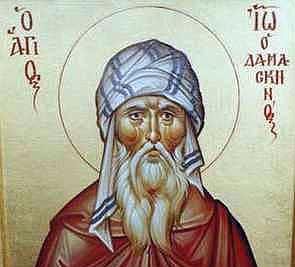St. John of Damascus was born around 675, and grew up under Muslim rule in Damascus. His parents were deeply religious Christians, and gave him a thorough education in theology. It was this education that prepared John to defend the tradition of sacred iconography.
At that time, Iconoclasts were entering churches and destroying the venerated images inside. The emperor had also issued a decree against sacred images. John fought back with public opposition, arguing that Christians did not worship images, but rather venerated them, while worshipping God, and honoring saints. He also argued that because Christ had taken an incarnate physical form on earth, he had allowed the Church to depict him in images.
John’s opposition made him a known enemy of the emperor, who forged a letter offering to betray the Damascus government in John’s name. The ruling caliph believed the letter, and is said to have had John’s hand cut off, but John’s surviving biography says that his hand was miraculously restored by Mary. John eventually convinced the caliph of his innocence. After this, he became a monk, and then a priest.
St. John also wrote the “Exact Exposition of the Orthodox Faith,” in which he systematized the Greek Fathers’ writings about theology in light of philosophy. St. Thomas Aquinas and many other scholars drew great inspiration from this work.
St. John died in 749 as a revered Father of the Church, and is sometimes called the last of the Church Fathers. In 1890 he was declared a Doctor of the Church by Pope Leo XIII.

